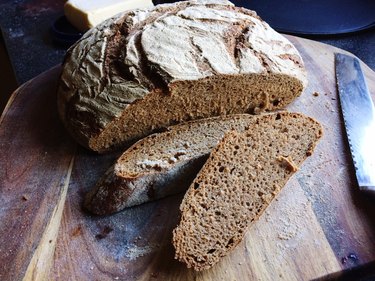
The recent rise in popularity of whole grains has the masses trading in their spongy white slices for something more nutritionally — and physically — dense. However, darker color doesn't automatically mean you're getting whole wheat bread.
If you rely on color alone, however, you may not choose a bread that contains fiber and nutrient-rich whole grains. That's because not all brown breads are created equal.
Video of the Day
Video of the Day
Tip
While it's darker color might make it seem healthier, brown bread isn't better for your health unless it's whole grain.
Read more: Whole-Grain Bread Vs. White Bread
Brown Isn't Necessarily Better
Wheat bread has a reputation for being the healthier choice. The truth is, many wheat breads are just white breads in disguise. They contain the same processed white flour as white bread with the addition of sugars or colorings to give them their darker appearance. Having a darker color isn't a reliable indicator of nutritional value. The phrase "wheat" on the label misleads consumers because most breads contain wheat, even white breads.
In fact, brown bread can contain even more sugar than it's white counterparts. According to the USDA, one slice of generic brown bread contain 3 grams of sugar while one slice of the white variety contains 1.64 grams. Brown bread calories can also be higher — 110 per slice versus 77 for the white version. However, this information varies by brand.
Choose Whole Wheat Bread
Whole-grain breads have a nutritional edge over breads with just processed grains because whole grains retain the germ and bran portion of each grain, according to Mayo Clinic. The bran packs bread with fiber and ups the magnesium, vitamin E and essential fatty acids. Breads without whole grains cast these parts of the plant aside and the nutritional content takes a hit. Make sure the bread you choose lists "100-percent whole wheat" on the packaging or "whole-grain wheat" in the ingredients list.
Benefits of Whole Grains
Bread manufacturers can add nutrients back into the breads through the fortification process, but not fiber, according to the USDA. Whole-grain bread helps you meet your daily fiber intake. The extra fiber in whole grains helps give you that full feeling. It also keeps you full longer, which can help promote weight loss.
Fiber helps regulate your digestive system and lowers cholesterol. Since whole grains take longer to digest than processed grains, they are believed to have less impact on your blood sugar, which can help control food cravings. However, a small study published in June 2017 by Cell Metabolism compared the effects of whole grain bread and industrially made white bread on blood sugar levels in 20 individuals and found no statistical difference between the two types.
Read more: Why Isn't White Bread Good for You?
Aim for 50 Percent
The USDA recommends that half the grains you eat each come from whole grains. It recommends 3 oz. of whole grain per day, and those grains can come from any combination of whole and processed grains. This is important because many brown breads contain a mixture of whole grains and processed grains.The USDA emphasizes that there is room for processed grains in a healthy diet as long as they're balanced with whole grains and not eaten in excess.
- Mayo Clinic: "Whole Grains: Hearty Options for a Healthy Diet"
- Cell Metabolism: "Bread Affects Clinical Parameters and Induces Gut Microbiome-Associated Personal Glycemic Responses"
- USDA National Nutrient Database: "Bread, White, Commercially Prepared (Includes Soft Bread Crumbs)"
- USDA National Nutrient Database: "Breads, 100% Whole Wheat"
- USDA: "All About the Grains Group"